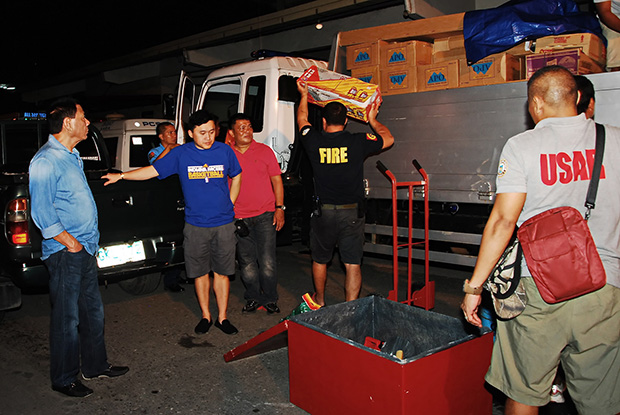DAVAO CITY (MindaNews /08 July) — There are still several barangays in the city that are ill-prepared for disasters, Central 911 head Emmanuel Jaldon said as he urged village officials to craft their own disaster risk reduction and management (DRRM) plans to help them prepare for disasters such as typhoons and strong earthquakes.
“The barangays have the obligation to prepare the community. There is improvement because other barangays are starting to have the DRRM plans but some of them are having difficulties in facilitating the planning and the personnel that they have are only a few. So, we assist them,” Jaldon told reporters Thursday.
 Davao City Mayor Rodrigo Duterte oversees the loading of logistics of 911’s Urban Search and Rescue Unit bound for Tacloban, Leyte tol help in the search and rescue efforts in Leyte in hte aftermath of super typhoon Yolanda in November 2013. MindaNews file photo by RENE B. LUMAWAG
Davao City Mayor Rodrigo Duterte oversees the loading of logistics of 911’s Urban Search and Rescue Unit bound for Tacloban, Leyte tol help in the search and rescue efforts in Leyte in hte aftermath of super typhoon Yolanda in November 2013. MindaNews file photo by RENE B. LUMAWAG
Central 911 has been reaching out to barangay officials through trainings and assisting them in crafting their own DRRM plans, he said. The city has 182 barangays.
Jaldon said barangay officials need to understand the importance of the DRR and putting up of hazard maps, early warning signages, directional signs pointing to the evacuation centers, and activating Barangay Disaster Risk Reduction Committee (BDRRMC). He declined to say how many of the city’s 182 barangays are ill-prepared.
But he noted that Central 911 has been regularly conducting trainings for all barangays in to encourage officials to put in place DRR measures such as the creation of a Barangay Disaster Risk Reduction Committee (BDRRMC) which is mandated by law, as well as putting up of early warning signages and directional signs to evacuation centers, mostly especially in coastal and landslide prone areas.
“We need warning signs that indicate these areas are susceptible to landslide. That’s the work of the barangay. They need to understand the DRR, which is very important,” he said.
Under Section 12.6.1 of the Republic Act (RA) 10121, or the Philippine Disaster Risk Reduction and Management Act of 2010, the provincial, city and municipal DRRMOs or Barangay Disaster Risk Reduction and Management Committees are tasked to “design, program, and coordinate disaster risk reduction and management activities consistent with the National Council’s standards and guidelines”.
He said they are now addressing this by holding regular trainings and visits to increase the disaster preparedness of the barangays and to ensure their DRR fund is utilized properly.
Disaster Consciousness month
Jaldon’s pronouncements are timely in that July is National Disaster Consciousness Month. This year’s theme is “Kahandaan at Pagtugon sa Sakuna, Tungkulin ng Bawat Isa” (Preparedness and Response to Disasters, Everyone’s responsibility).
Jaldon also said that even as some barangay officials are not cooperating, there are those who take the initiative to plan out their own DRRM measures.
He said Central 911 will focus on conducting a full-scale exercise on earthquake and tsunami that will include the barangays, households, City Government, and even Davao Region as a whole.
“Resiliency is also a matter of attitude of the people. Once they know the area is very vulnerable to flooding, they prepare accordingly,” he added.
Well equipped
In a press release from the City Information Office (CIO), Jaldon reminded residents to prepare for the rainy season even as the readiness of city’s Central 911 unit is high, with its emergency center and 24/7 response units equipped with electronic and manual sirens across vulnerable communities, rubber boats, and other facilities needed in evacuation and rescue.
He added that the local government is ready and well-equipped to respond to disasters — including flashflood — that might be brought by a long and heavy downpour.
The press release cited Philippine Atmospheric Geophysical Astronomical Services Administration (Pagasa) forecast that La Niña will hit the country sometime August or September.
It added that acting Mayor Paolo Duterte has created a special team to handle the city’s flood problem while noting that the City Government has requested two pumping stations from the national government to control or mitigate the flood.
“The Baha Team will receive all the complaints concerning floods in different areas in Davao,” Duterte said. “They will address the complaints and they will assess and recommend of what the city should do to remedy the problem.”
Jaldon reminded residents of low-lying and coastal areas to have a ‘grab kit’ or ‘survival kit’ that contains few canned goods and other food packs that can last for three days, with bottled water, first-aid and some medicines while important documents must also be secured.
“The survival kit must be placed where it can be easily grabbed in case of disaster,” Jaldon said, adding that they must have fully-charged mobile phones, flashlights, and radio sets in case of emergency. (Antonio L. Colina IV / MindaNews)
